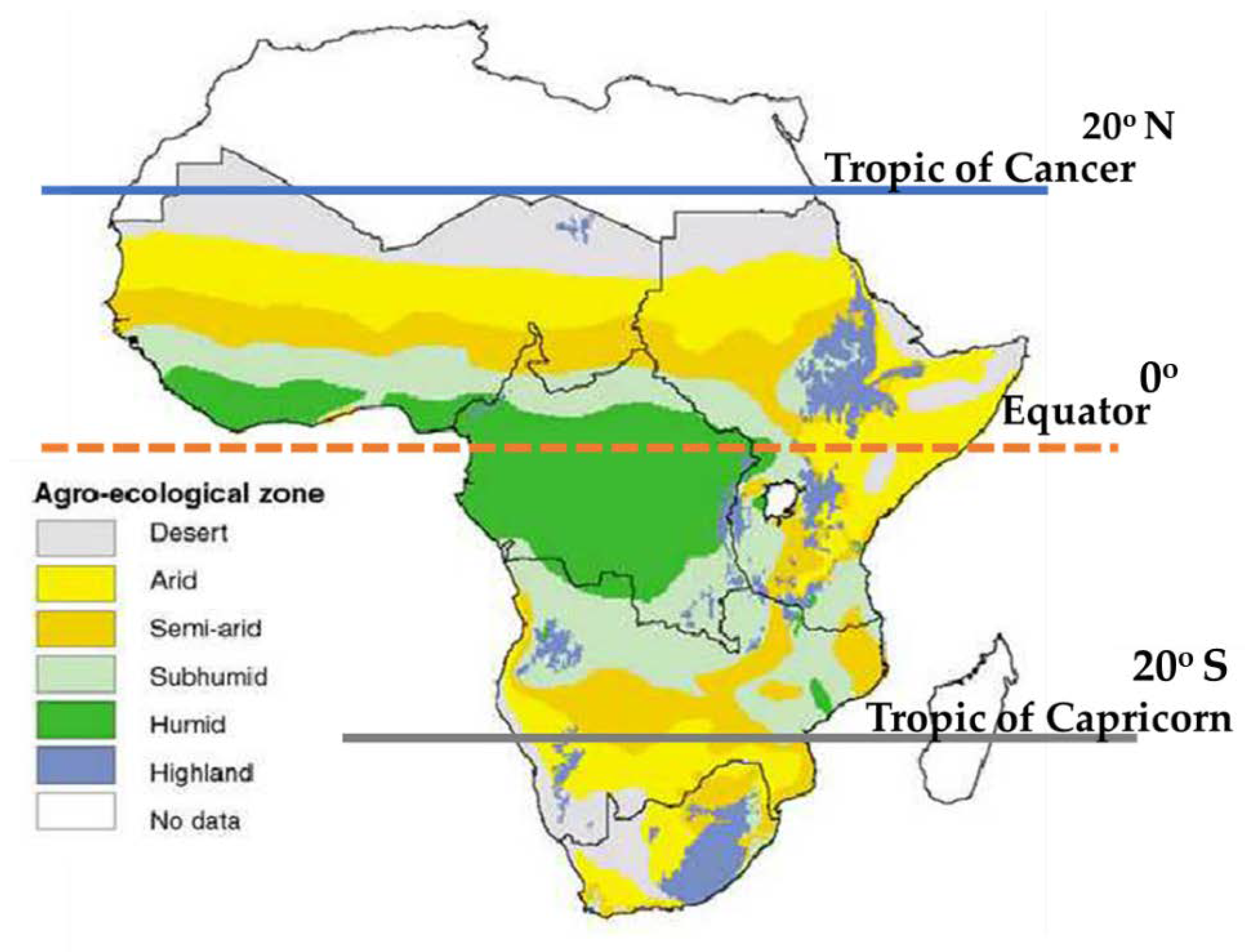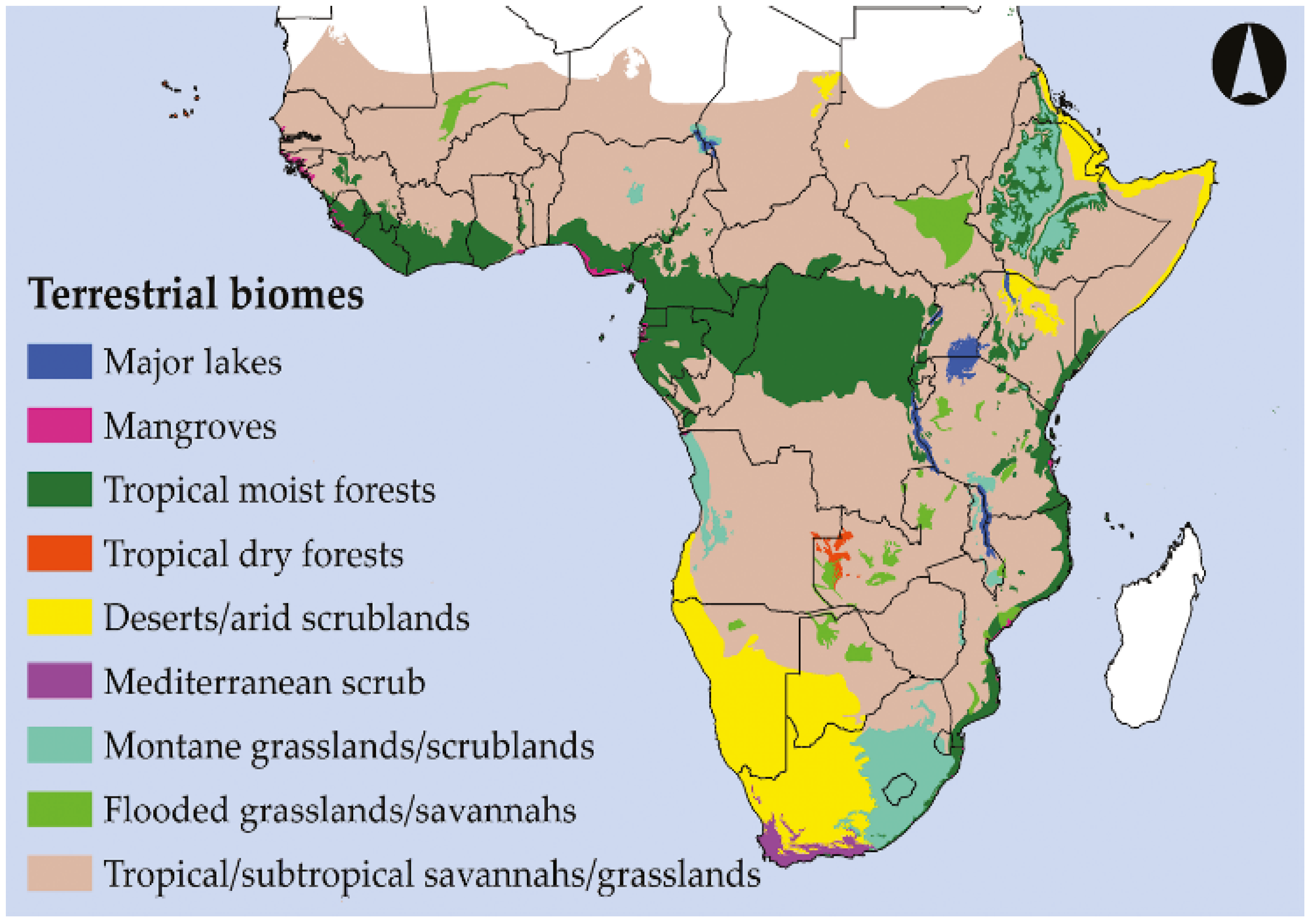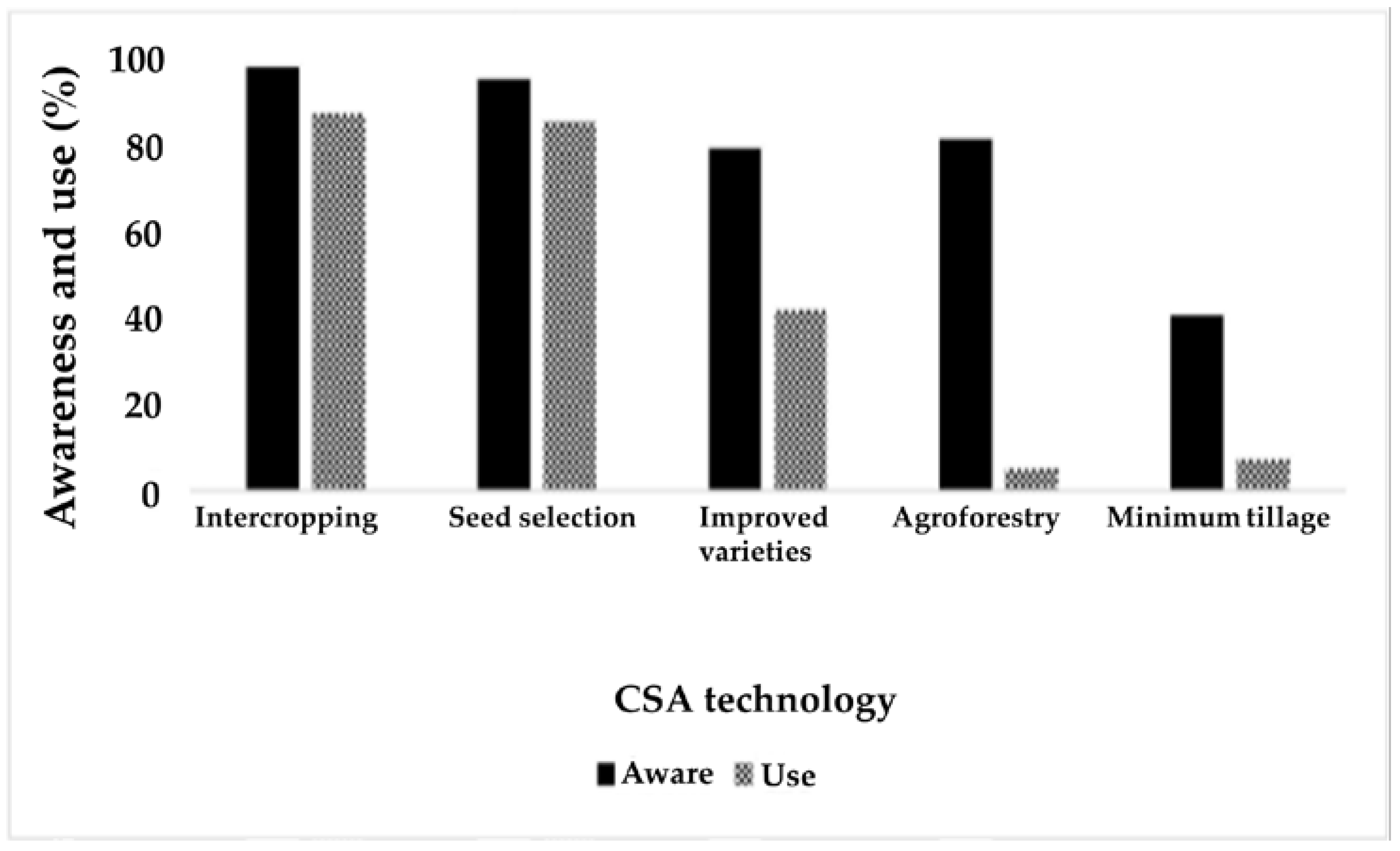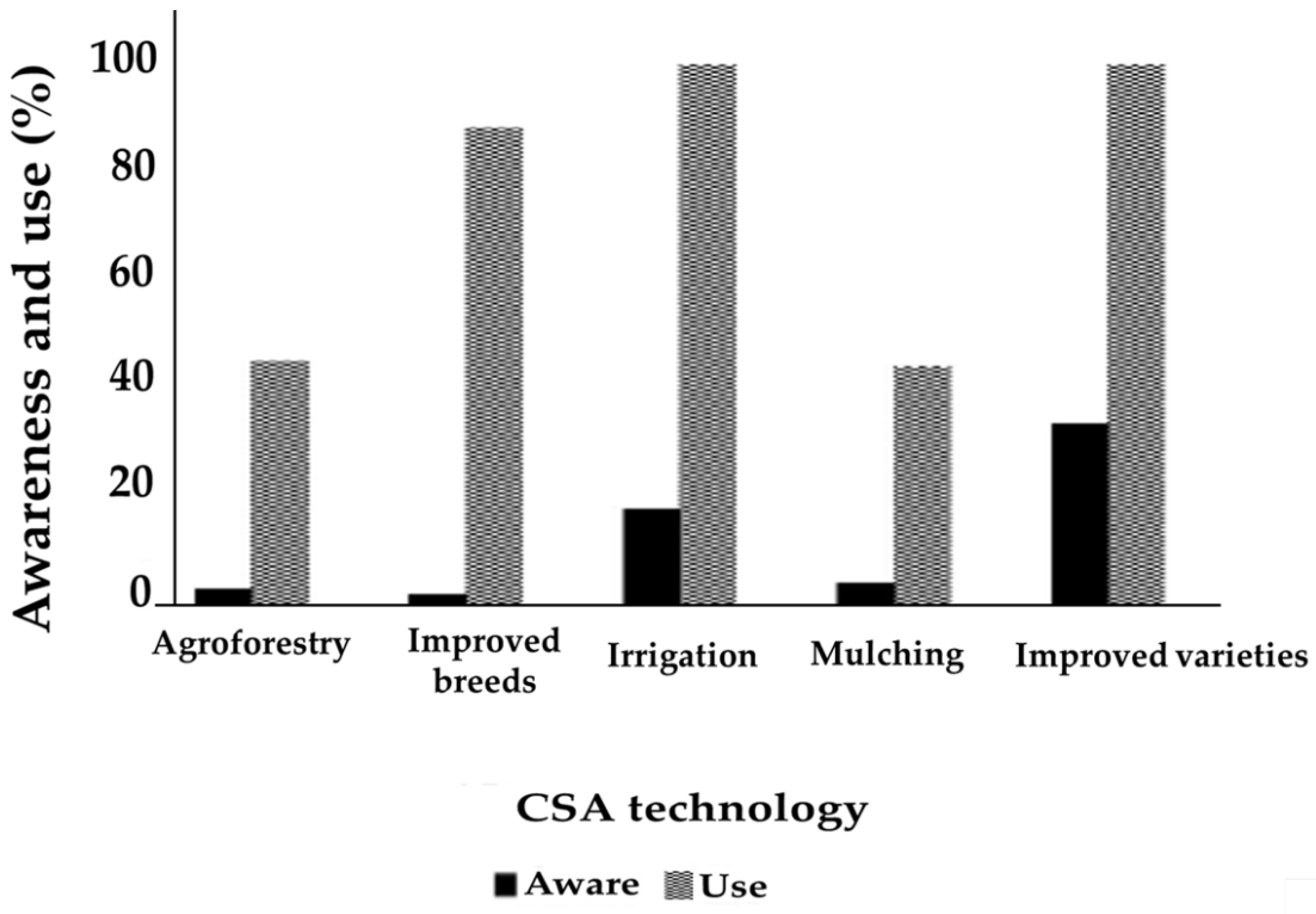A Review of Climate-Smart Agriculture Technology Adoption by Farming Households in Sub-Saharan Africa
Abstract
:1. Introduction
The Role of Climate-Smart Agriculture
2. Materials and Methods
3. Results and Discussion
3.1. Review of CSA in Africa: Core Issues and Constraints in Agriculture
3.2. The Role of CSA Technology Options, Utilization, and Adaptation
3.3. Sub-Sahara Africa Population Distribution in Rural and Urban Cities
3.4. Farmer Households and Demographic Change
3.5. Current Knowledge on the State of CSA Farmer Household Adoption in SSA
4. Conclusions
Author Contributions
Funding
Institutional Review Board Statement
Informed Consent Statement
Data Availability Statement
Acknowledgments
Conflicts of Interest
References
- Bolin, B. A history of the Science and Politics of Climate Change: The Role of the Intergovernmental Panel on Climate Change; Cambridge University Press: Cambridge, UK, 2007. [Google Scholar]
- USAID. Climate Change Information Fact Sheet EGYPT. USAID Fact Sheet Report. 2015. Available online: https://www.climatelinks.org/sites/default/files/asset/document/Egypt%20Climate%20Info%20Fact%20Sheet_FINAL.pdf (accessed on 25 September 2021).
- Connor, P. International Migration from Sub-Saharan Africa has Grown Dramatically Since 2010; Sub-Saharan Migration to the United States also Growing; Pew Research Center: Washington, DC, USA, 2018; Available online: https://www.pewresearch.org/fact-tank/2018/02/28/international-migration-from-sub-saharan-africa-has-grown-dramatically-since-2010/ (accessed on 25 September 2021).
- Fraval, S.; Hammond, J.; Bogard, J.R.; Ng’endo, M.; van Etten, J.; Herrero, M.; Oosting, S.J.; de Boer, I.J.; Lannerstad, M.; Teufel, N.; et al. Food access deficiencies in sub-Saharan Africa: Prevalence and implications for agricultural interventions. Front. Sustain. Food Syst. 2019, 3, 104. [Google Scholar] [CrossRef] [Green Version]
- FAO. Climate Change and Food Security: Risk and Responses. 2015. Available online: www.fao.org/publications (accessed on 10 May 2021).
- Yamba, S.; Appiah, D.O.; Siaw, L.P. Smallholder farmers’ perceptions and adaptive response to climate variability and climate change in southern rural Ghana. Cogent Soc. Sci. 2019, 5, 1646626. [Google Scholar] [CrossRef]
- Available online: www.acetforafrica.org (accessed on 10 May 2021).
- Partey, S.T.; Zougmoré, R.B.; Ouédraogo, M.; Campbell, B.M. Developing climate-smart agriculture to face climate variability in West Africa: Challenges and lessons learnt. J. Clean. Prod. 2018, 187, 285–295. [Google Scholar] [CrossRef]
- FAO. Food Security and Agricultural Mitigation in Developing Countries: Options for Capturing Synergies FAO Rome. 2009. Available online: http://www.fao.org/docrep/012/i1318e/i1318e00.pdf (accessed on 23 May 2021).
- FAO. Climate-Smart Agriculture: Climate Change; Climate-Smart Agriculture|Food and Agriculture Organization of the United Nations: Rome, Italy, 2010. [Google Scholar]
- Sub-Saharan-Africa. World Regional Geography. Available online: https://andmcintyre.weebly.com (accessed on 7 June 2021).
- Nelson, S.; Huyer, S. A Gender-Responsive Approach to Climate-Smart Agriculture: Evidence and Guidance for Practitioners; 2016; Available online: https://www.fao.org/3/be879e/be879e.pdf (accessed on 25 September 2021).
- Snyder, H. Literature review as a research methodology: An overview and guidelines. J. Bus. Res. 2019, 104, 333–339. [Google Scholar] [CrossRef]
- Halcomb, E.; Hickman, L. Mixed methods research. Nursing Standard: Promoting excellence in nursing care. Univ. Wollongong 2015, 29, 41–47. [Google Scholar]
- Paul, J.; Criado, A.R. The art of writing literature review: What do we know and what do we need to know? Int. Bus. Rev. 2020, 29, 101717. [Google Scholar] [CrossRef]
- Faurès, J.M.; Santini, G. Water and the Rural Poor: Interventions for Improving Livelihoods in Sub-Saharan Africa. 2008. Available online: https://reliefweb.int/report/world/water-and-rural-poor-interventions-improving-livelihoods-sub-saharan-africa(accessed on 25 September 2021).
- Available online: https://www.africa.undp.org/content/rba/en/home/regioninfo.html (accessed on 11 April 2021).
- FAO; IIASA. Global Agro-Ecological Zones (GAEZ); 2000. Available online: https://iiasa.ac.at/web/home/research/researchPrograms/water/GAEZ_v4.html (accessed on 25 September 2021).
- Wilson, J.W.; Primack, R.B. Conservation Biology in Sub-Saharan Africa; Open Book Publishers: Cambridge, UK, 2019; pp. 23–60. Available online: https://www.openbookpublishers.com/product/1013 (accessed on 25 September 2021).
- Girvetz, E.; Ramirez-Villegas, J.; Claessens, L.; Lamanna, C.; Navarro-Racines, C.; Nowak, A.; Rosenstock, T.S. Future Climate Projections in Africa: Where Are We Headed? In The Climate-Smart Agriculture Papers; Springer: Cham, Switzerland, 2019; pp. 15–27. [Google Scholar]
- Zougmoré, R.B.; Läderach, P.; Campbell, B.M. Transforming Food Systems in Africa under Climate Change Pressure: Role of Climate-Smart Agriculture. Sustainability 2021, 13, 4305. [Google Scholar] [CrossRef]
- Osumba, J.J.L.; Recha, J.W.; Oroma, G.W. Transforming Agricultural Extension Service Delivery through Innovative Bottom-Up Climate-Resilient Agribusiness Farmer Field Schools. Sustainability 2021, 13, 3938. [Google Scholar] [CrossRef]
- Obi, A.; Maya, O. Innovative Climate-Smart Agriculture (CSA) Practices in the Smallholder Farming System of South Africa. Sustainability 2021, 13, 6848. [Google Scholar] [CrossRef]
- Beattie, S.; Sallu, S.M. How Does Nutrition Feature in Climate-Smart Agricultural Policy in Southern Africa? A Systematic Policy Review. Sustainability 2021, 13, 2785. [Google Scholar] [CrossRef]
- Geda, S.A.; Kühl, R. Exploring Smallholder Farmers’ Preferences for Climate-Smart Seed Innovations: Empirical Evidence from Southern Ethiopia. Sustainability 2021, 13, 2786. [Google Scholar] [CrossRef]
- Zeleke, T.; Beyene, F.; Deressa, T.; Yousuf, J.; Kebede, T. Vulnerability of Smallholder Farmers to Climate change-induced Shocks in East Hararghe Zone, Ethiopia. Sustainability 2021, 13, 2162. [Google Scholar] [CrossRef]
- Ofoegbu, C.; Chirwa, P.W.; Francis, J.; Babalola, F.D. Assessing local-level forest use and management capacity as a climate-change adaptation strategy in Vhembe district of South Africa. Clim. Dev. 2019, 11, 501–512. [Google Scholar] [CrossRef]
- Climate Change and Agriculture A Perfect Storm in Farm Country. Available online: https://www.ucsusa.org/resources/climate-change-and-agriculture (accessed on 11 April 2021).
- Upscaling Climate-Smart Agriculture (CSA) Adoption in Africa. Available online: http://www.fao.org/fileadmin/user_upload/gacsa/docs/POLICY_BRIEF_-_CSA.pdf(accessed on 18 August 2021).
- Onoja, A.O.; Abraha, A.Z.; Girma, A.; Achike, A.I. Climate-smart agricultural practices (CSA) adoption by crop farmers in semi-arid regions of the west and east Africa: Evidence from Nigeria and Ethiopia. In Climate Change-Resilient Agriculture and Agroforestry; Springer: Cham, Switzerland, 2019; pp. 89–113. [Google Scholar]
- Kurgat, B.K.; Lamanna, C.; Kimaro, A.; Namoi, N.; Manda, L.; Rosenstock, T.S. Adoption of climate-smart agriculture technologies in Tanzania. Front. Sustain. Food Syst. 2020, 4, 55. [Google Scholar] [CrossRef]
- Bell, P.; Namoi, N.; Lamanna, C.; Corner-Dolloff, C.; Girvetz, E.H.; Thierfelder, C.; Rosenstock, T.S. A Practical Guide to Climate-Smart Agriculture Technologies in Africa; CCAFS Working Paper no. 224.; CGIAR Research Program on Climate Change, Agriculture and Food Security (CCAFS): Wageningen, The Netherlands, 2018. [Google Scholar]
- Barasa, P.M.; Botai, C.M.; Botai, J.O.; Mabhaudhi, T. A Review of Climate-Smart Agriculture Research and Applications in Africa. Agronomy 2021, 11, 1255. [Google Scholar] [CrossRef]
- Field, C.B.; Barros, V.R. (Eds.) Climate Change 2014–Impacts, Adaptation and Vulnerability: Regional Aspects; Cambridge University Press: Cambridge, UK, 2014; Available online: https://www.ipcc.ch/report/ar5/wg2/ (accessed on 25 September 2021).
- How Climate Change is Making Record-Breaking Floods the New Normal. Available online: https://www.unep.org/news-and-stories/story/how-climate-change-making-record-breaking-floods-new-normal (accessed on 9 July 2021).
- Serdeczny, O.; Adams, S.; Baarsch, F.; Coumou, D.; Robinson, A.; Hare, W.; Schaeffer, M.; Perrette, M.; Reinhardt, J. Climate change impacts in Sub-Saharan Africa: From physical changes to their social repercussions. Reg. Environ. Chang. 2017, 17, 1585–1600. [Google Scholar] [CrossRef]
- Asante, F.A.; Amuakwa-Mensah, F. Climate Change and Variability in Ghana: Stocktaking. Climate 2015, 3, 78–99. [Google Scholar] [CrossRef] [Green Version]
- Morales-Muñoz, H.; Jha, S.; Bonatti, M.; Alff, H.; Kurtenbach, S.; Sieber, S. Exploring Connections—Environmental Change, Food Security and Violence as Drivers of Migration—A Critical Review of Research. Sustainability 2020, 12, 5702. [Google Scholar] [CrossRef]
- World Bank. Ending Poverty and Hunger by 2030: An Agenda for the Global Food System, 2nd ed.; World Bank Group: Washington, DC, USA, 2015. [Google Scholar]
- Rippke, U.; Ramirez-Villegas, J.; Jarvis, A.; Vermeulen, S.J.; Parker, L.; Mer, F.; Diekkrüger, B.; Challinor, A.J.; Howden, M. Timescales of transformational climate change adaptation in sub-Saharan African agriculture. Nat. Clim. Chang. 2016, 6, 605–609. [Google Scholar] [CrossRef]
- Müller, C.; Waha, K.; Bondeau, A.; Heinke, J. Hotspots of climate change impacts in sub-Saharan Africa and implications for adaptation and development. Glob. Chang. Biol. 2014, 20, 2505–2517. [Google Scholar] [CrossRef]
- Shi, W.; Tao, F. Vulnerability of African maize yield to climate change and variability during 1961–2010. Food Secure. 2014, 6, 471–481. [Google Scholar] [CrossRef]
- Rurinda, J.; Van Wijk, M.T.; Mapfumo, P.; Descheemaeker, K.; Supit, I.; Giller, K.E. Climate change and maize yield in southern Africa: What can farm management do? Glob. Chang. Biol. 2015, 21, 4588–4601. [Google Scholar] [CrossRef]
- Ahmed, S.; Griffin, T.S.; Kraner, D.; Schaffner, M.K.; Sharma, D.; Hazel, M.; Leitch, A.R.; Orians, C.M.; Han, W.; Stepp, J.R.; et al. Environmental Factors Variably Impact Tea Secondary Metabolites in the Context of Climate Change. Front. Plant Sci. 2019, 10, 939. [Google Scholar] [CrossRef] [Green Version]
- Vogel, C.; Steynor, A.; Manyuchi, A. Climate services in Africa: Re-imagining an inclusive, robust and sustainable service. Clim. Serv. 2019, 15, 100107. [Google Scholar] [CrossRef]
- Batley, J.; Edwards, D. The application of genomics and bioinformatics to accelerate crop improvement in a changing climate. Curr. Opin. Plant Biol. 2016, 30, 78–81. [Google Scholar] [CrossRef] [PubMed] [Green Version]
- Harfouche, A.L.; Jacobson, D.A.; Kainer, D.; Romero, J.C.; Harfouche, A.H.; Mugnozza, G.S.; Moshelion, M.; Tuskan, G.A.; Keurentjes, J.J.; Altman, A. Accelerating climate resilient plant breeding by applying next-generation artificial intelligence. Trends Biotechnol. 2019, 37, 1217–1235. [Google Scholar] [CrossRef] [PubMed]
- Mortimer, J.C. Plant synthetic biology could drive a revolution in biofuels and medicine. Exp. Biol. Med. 2019, 244, 323–331. [Google Scholar] [CrossRef] [Green Version]
- SDG Knowledge Hub, CIAT Strategy Responds to Climate Change, Land Degradation. Available online: http://sdg.iisd.org/news/ciat-strategy-responds-to-climate-change-land-degradation/ (accessed on 12 August 2021).
- Khatri-Chhetri, A.; Aggarwal, P.K.; Joshi, P.K.; Vyas, S. Farmers’ prioritization of climate-smart agriculture (CSA) technologies. Agric. Syst. 2017, 151, 184–191. [Google Scholar] [CrossRef]
- Ruddle, K.; Zhong, G. Integrated Agriculture-Aquaculture in South China: The Dike-Pond System of the Zhujiang Delta; CUP Archive: Cambridge, UK, 1988; Available online: https://www.researchgate.net/publication/258212339_Integrated_Agriculture-Aquaculture_in_South_China_The_Dike-Pond_System_of_the_Zhujiang_Delta (accessed on 25 September 2021).
- Kipkoech, A.K.; Tambi, E.N.; Bangali, S.; FARA. State of Knowledge on CSA in Africa, Case Studies from Ethiopia, Kenya and Uganda; Forum for Agricultural Research in Africa: Accra, Ghana, 2015; Available online: https://www.worldcat.org/title/state-of-knowledge-on-csa-in-africa-case-studies-from-ethiopia-kenya-and-uganda/oclc/968333705 (accessed on 25 September 2021).
- Chinedum, N.; Tambi, E.N.; Bangali, S. State of Knowledge on CSA in Africa: Case Studies from Burkina Faso, Senegal and Sierra Leone; Forum for Agricultural Research in Africa: Accra, Ghana, 2015. [Google Scholar]
- Urbanization in Sub-Saharan Africa. Available online: statista.com (accessed on 17 July 2021).
- Fleshman, M. Saving Africa’s forests, the ‘lungs of the world’. Afr. Renew. 2008, 21, 5–7. [Google Scholar] [CrossRef]
- Pigford, A.A.E.; Hickey, G.M.; Klerkx, L. Beyond agricultural innovation systems? Exploring an agricultural innovation ecosystems approach for niche design and development in sustainability transitions. Agric. Syst. 2018, 164, 116–121. [Google Scholar] [CrossRef]
- Rudel, T.K. The national determinants of deforestation in sub-Saharan Africa. Philos. Trans. R. Soc. B Biol. Sci. 2013, 368, 20120405. [Google Scholar] [CrossRef] [Green Version]
- Dixon-Woods, M.; Agarwal, S.; Young, B.; Jones, D.; Sutton, A. Integrative Approaches to Qualitative and Quantitative Evidence; Health Development Agency: London, UK, 2004; p. 181. [Google Scholar]
- Thapa, R.B.; Murayama, Y. Drivers of urban growth in the Kathmandu valley, Nepal: Examining the efficacy of the analytic hierarchy process. Appl. Geogr. 2010, 30, 70–83. [Google Scholar] [CrossRef]
- Hasegawa, T.; Fujimori, S.; Havlík, P.; Valin, H.; Bodirsky, B.L.; Doelman, J.C.; Fellmann, T.; Kyle, P.; Koopman, J.F.; Lotze-Campen, H.; et al. Risk of increased food insecurity under stringent global climate change mitigation policy. Nat. Clim. Chang. 2018, 8, 699–703. [Google Scholar] [CrossRef] [Green Version]
- Countries and Territories. Available online: http://www.fao.org/faostat/en/ (accessed on 5 May 2021).
- Abegunde, V.O.; Sibanda, M.; Obi, A. The dynamics of climate change adaptation in Sub-Saharan Africa: A review of climate-smart agriculture among small-scale farmers. Climate 2019, 7, 132. [Google Scholar] [CrossRef] [Green Version]
- Anuga, S.W.; Gordon, C.; Boon, E.; Surugu, J.M.I. Determinants of Climate-Smart Agriculture (CSA) Adoption among Smallholder Food Crop Farmers in the Techiman Municipality, Ghana. Ghana J. Geogr. 2019, 11, 124–139. [Google Scholar]
- Food and Agriculture Organization (FAO) of United Nations. Climate-Smart Agriculture Sourcebook; United Nations FAO: Rome, Italy, 2013; Available online: https://www.fao.org/3/i3325e/i3325e.pdf (accessed on 25 September 2021).
- Ministry of Food and Agriculture—MOFA. National Climate-Smart Agriculture Action Plan (2016–2020); Ministry of Food and Agriculture: Accra, Ghana, 2015. [Google Scholar]
- Ingham, K.; Mascarenhas, A.C.; Chiteji, F.M.; Bryceson, D.F. Tanzania. Encyclopedia Britannica, 19 March 2021. Available online: https://www.britannica.com/place/Tanzania (accessed on 25 September 2021).
- Totin, E.; Roncoli, C.; Traoré, P.S.; Somda, J.; Zougmoré, R. How does institutional embeddedness shape innovation platforms? A diagnostic study of three districts in the Upper West Region of Ghana. NJAS-Wagening. J. Life Sci. 2018, 84, 27–40. [Google Scholar] [CrossRef]
- Yamba, S.; Appiah, D.O.; Pokuaa-Siaw, L.; Asante, F. Smallholder Farmers’ Livelihood Security Options Amidst Climate Variability and Change in Rural Ghana. Scientifica 2017, 2017, 1868290. [Google Scholar]
- Schellnhuber, H.J.; Hans, J.; Katja, F.; Pavel, K. The Elephant, the Blind, and the Intersectoral Intercomparison of Climate Impacts. Proc. Natl. Acad. Sci. USA 2014, 111, 3225–3227. Available online: https://www.pnas.org/content/111/9/3225 (accessed on 25 September 2021).
- Adenle, A.A.; Wedig, K.; Azadi, H. Sustainable agriculture and food security in Africa: The role of innovative technologies and international organizations. Technol. Soc. 2019, 58, 101143. [Google Scholar] [CrossRef]
- World Population Prospects—Population Division. United Nations Department of Economic and Social Affairs, Population Division. Available online: population.un.org (accessed on 25 September 2021).






| Author and Year | Contribution | Geographical Location/Region |
|---|---|---|
| Girvetz. et al., 2019 [20] | Climate-Smart Foresight | Eastern and Southern Africa |
| Zougmore et al., 2021 [21] | Food System Transformation | Sub-Saharan Africa |
| Osumba et al., 2021 [22] | Extension Service Delivery | South Africa |
| Ajuruchuku and Okuhle, 2021 [23] | Innovative CSA practices | South Africa |
| Beattie and Sallu, 2021 [24] | CSA Policy | Burkina Faso, Senegal and Sierra Leone |
| Shimelis and Rainer, 2021 [25] | Seed Innovation | Ethiopia |
| Titay et al., 2021 [26] | Smallholder Farmers Vulnerability | Sub-Saharan Africa (Ethiopia) |
| Ofoegbu, et al., 2019 [27] | Climate Change Adaptation Strategies | South Africa |
| http://www.climatelinks.org 12 August 2021 [28] | Adaptation | Africa |
| Biennial Climate-Smart Agriculture Stakeholders Conference—Policy Brief FARA 2020 [29] | Policy Brief | Africa |
| Onoja et al., 2019 [30] | CSA Practices and Adaptation | West and East Africa |
| Kurgat et al., 2020 [31] | CSA Technology Adaptation | Tanzania |
| Partey et al., 2018 [8] | CSA Challenges and Lessons Learnt | West Africa |
| Bell et al., 2018 [32] | CSA Technologies Guide | Africa |
| Barasa et al., 2021 [33] | CSA Application | Africa |
| Practices | Responses (%) |
|---|---|
| Yes | |
| Weather smart | |
| Use personal experience to predict weather events | 85.0 |
| Usage information from radio/T.V for weather events | 75.3 |
| Received training/education from an extension worker/agent on weather | 54.4 |
| Use a mobile phone to access weather information | 19.6 |
| Access to weather information on the internet | 11.8 |
| Water smart | |
| Plant early during the rainy season to make use of rainwater | 76.8 |
| Plant cover crops to maintain soil moisture | 43.4 |
| Harvest and store rainwater for future use in watering crops and feeding animals | 12.5 |
| Carbon and nitrogen smart | |
| Use organic manuring | 94.7 |
| Practice mixed cropping | 94.7 |
| Use trees as farm boundaries (afforestation) | 81.6 |
| Practice crop rotation | 72.8 |
| Plant legumes among crops | 82.5 |
| Estimate the amount of fertilizer/manure needed at a time (precision fertilization) | 53.7 |
| Use specific fertilizer/manure based on the type of soil (site-specific nutrients application) | 30.0 |
| Energy smart | |
| Compost residue after harvesting | 70.6 |
| Convert residue into bioenergy | 14.0 |
| Use solar equipment in farming | 10.9 |
| Knowledge smart | |
| Farmer-to-farmer knowledge sharing | 87.2 |
| Belonging to a farmer association | 86.9 |
| Store seeds for next season/emergency (seed banking) | 84.4 |
| Get access to market information on prices of outputs and input | 40.0 |
| Issues | Mean |
|---|---|
| Economic | |
| Access to sustainable agriculture technologies | 4.64 |
| Experience of bush fires | 4.02 |
| Drought occurrence | 4.89 |
| Experience of weeds and pesticides | 4.02 |
| Knowledge of climate-smart agriculture | 4.93 |
| Government or private sector support | 3.48 |
| Access to extension services | 3.90 |
| Availability of CSA funds by government and farmer organizations | 4.25 |
Publisher’s Note: MDPI stays neutral with regard to jurisdictional claims in published maps and institutional affiliations. |
© 2021 by the authors. Licensee MDPI, Basel, Switzerland. This article is an open access article distributed under the terms and conditions of the Creative Commons Attribution (CC BY) license (https://creativecommons.org/licenses/by/4.0/).
Share and Cite
Kombat, R.; Sarfatti, P.; Fatunbi, O.A. A Review of Climate-Smart Agriculture Technology Adoption by Farming Households in Sub-Saharan Africa. Sustainability 2021, 13, 12130. https://doi.org/10.3390/su132112130
Kombat R, Sarfatti P, Fatunbi OA. A Review of Climate-Smart Agriculture Technology Adoption by Farming Households in Sub-Saharan Africa. Sustainability. 2021; 13(21):12130. https://doi.org/10.3390/su132112130
Chicago/Turabian StyleKombat, Richard, Paolo Sarfatti, and Oluwole Abiodun Fatunbi. 2021. "A Review of Climate-Smart Agriculture Technology Adoption by Farming Households in Sub-Saharan Africa" Sustainability 13, no. 21: 12130. https://doi.org/10.3390/su132112130
APA StyleKombat, R., Sarfatti, P., & Fatunbi, O. A. (2021). A Review of Climate-Smart Agriculture Technology Adoption by Farming Households in Sub-Saharan Africa. Sustainability, 13(21), 12130. https://doi.org/10.3390/su132112130








